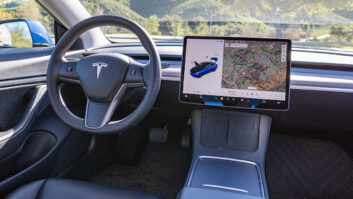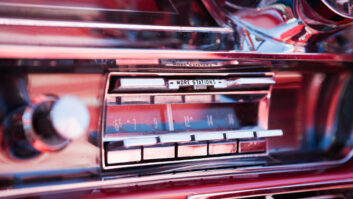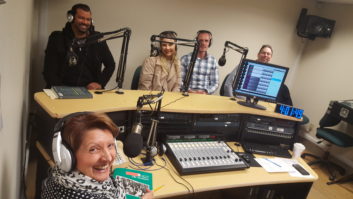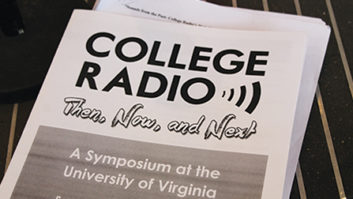A Look at Receiver Design Elements That Affect Your FM HD Coverage Area
(click thumbnail)Fig. 1 Desired-to-undesired (D/U) ratio of three IBOC receivers when the FM IBOC signal is jammed by various analog FM adjacents. The scale on the left is in dB.
IBOC coverage area has been the focus of station engineers and others in the past few years. It has gained more attention recently as more HD Radios are available.
The design of the receiver used in an IBOC coverage test certainly impacts this performance, of course. This article discusses some of these design elements and focuses in on a few points that appear to really impact your FM HD coverage area.
An IBOC receiver design engineer can take a few design elements for granted. For example, the Ibiquity firmware, as delivered, takes care of the Forward Error Correction decoding. Some other basic OFDM receiver functions are the de-interleaver, OFDM symbol timing and frequency lock, and subcarrier demodulation.
Still, the receiver designer has some choices to make as the licensed firmware only goes so far.
Basic design tradeoffs
All designs start with a list of requirements that must be met for the intended application. In the RF front-end section, this list typically includes Automatic Gain Control tracking factors; linearity; noise figure; phase noise and absolute frequency accuracy; and interference rejection.
The choice of AGC parameters depends a lot on how and where the receiver will be used. Home receivers are subject to flat fading due to multipath, but it is a relatively constant effect compared to mobile receivers, which see a much more dynamic environment.
For mobile, the rule of thumb is that multipath fades will occur at about ?/2 distances; for FM it works out to a few feet from peak to fade.
On the other hand, a mobile receiver is likely to have a better signal coming in from the antenna; it is typically outdoors and probably has higher passive gain. These factors affect the AGC design, since AGC must respond dynamic to the signal environment.
Front-end linearity, particularly at high signal strengths, is as important for digital receivers as it is for analog receivers. For an IBOC receiver, the front-end noise figure is not as challenging a design requirement as it is in a satellite receiver.
Satellite signal reception is very dependent on raw sensitivity and is usually specified as a figure of merit known as G/T, or gain over noise temperature – but phase noise is every bit as challenging. The reason for the latter is that phase noise causes inter-carrier interference between subcarriers in an OFDM receiver.
While we’re discussing the tuning section, IBOC has stringent frequency accuracy requirements. This applies to the tuner section, and also the sample clock.
Last in this list, but not least, is rejecting adjacent-channel, in-band and wide-band interference.
Any single design choice in this inventory is likely to affect several other items on the list, plus the overall cost. Cost drives much of the performance, in the end, since consumers are, unfortunately, more able to discern a slight difference in price than they are able to detect differences in performance.
Performance factors
(click thumbnail)Fig. 2 IBOC coverage snapshot of WETA(FM), Washington. Green dots indicate digital audio, red indicate no coverage at that point.
Discussing all of these design parameters would take too many pages. However, two key performance factors for IBOC are sensitivity and interference rejection. These areas have a lot to do with the overall coverage area.
IBOC receivers have been known to pull in digital audio at field strengths down to 35dBu. However, several studies have established “reliable digital audio” in a variety of ranges.
For FM, the Tomorrow Radio study concluded that the “usable service area would fall within the 60 to 70dBu service area of a typical FM station.” A recent paper by John Kean of NPR Labs showed that NPR member stations that participated in HD Radio coverage measurements had contour-based results which fell in a wide range, from below 60dBu to above 85dBu for 97 percent digital coverage (RW June 7, page 26).
This spread in contour levels of more than 25 dB, indicates, as Kean mentioned, that the contour approach to coverage can be improved by looking at other factors, such as environmental noise and adjacent interferers.
So although the field strength at the receive antenna is the most important criteria, there are other factors at work as well. The next most important factor is the strength of other signals in-band, which brings us back to the receiver front-end design.
In a static test, receivers generally perform quite well for adjacent rejection. Fig. 1 shows the static (no fading) performance of several HD Radio receivers. For each receiver, the criterion was “digital audio.” The bars on the chart show the strength of various adjacent signals needed to force the receiver to blend to analog.
One thing to notice here is that there is almost 20 dB difference between the best and the worst receiver for the first-adjacent signal. Clearly, there is going to be some variation in the field from model to model for these critical parameters.
The chart also shows that, for a second adjacent signal, all the receivers were able to handle an undesired signal almost 50 dB stronger than the desired signal.
However, close examination of coverage plots reveals a different story. Note Fig. 2, which is taken from the Tomorrow Radio test report. One of the receivers in Fig. 1 was used in this Tomorrow Radio test project, so we can directly compare the results of the lab test to the field test of the same receiver. The station tested is WETA (90.9 MHz, 75 kW ERP, 186m HAAT).
Fig. 2 shows that for the westbound route, which is the upper left-hand route, the receiver had digital audio (noted in green) to 54 dBu which runs right through the first red area on the trace. However, in the south-south-west route, performance was limited to 65 dBu. So a single station has a wide spread between two routes when considering received field strength.
This dichotomy shows up time and again in field-testing IBOC receivers. The weaker performance can usually be matched with a strong adjacent signal.
In the WETA case, the difference appears to be due to the presence of a second-adjacent in the south, specifically, WJYJ (90.5 MHz, 38 kW ERP, 164m HAAT). In the area where the premature digital muting occurs, estimated desired-to-undesired ratio (D/U ratio) is on the close order of -10dB.
From Fig. 1, the receiver should have been able to handle down to -40dB D/U or even worse. To the west, signal strength limited the receiver; to the south a combination of signal strength and the adjacent interferer limited the receiver.
Other stations have second adjacents, and get better performance. Still others get worse performance.
There isn’t a definitive answer yet. However, one factor could be terrain-correlated slow fading. Fast fading is due to multipath; slow fading comes from morphology.
When the receiver is in such a fading channel, the two signals – desired and undesired – fade, but the fading is not independent or entirely random.
Imagine traveling away from WETA, toward WJYJ, and going over a hill. As you go over the hill, WJYJ is getting stronger, but WETA is getting weaker.
Clearly, the slow fade statistics are not independent. Imagine the sharp swing in D/U ratio under these conditions – the desired signal is dropping, but the undesired is rising. This tendency to correlate the strength of one to the weakness of the other leads to a reduction in the performance in the face of an interfering adjacent.
This doesn’t explain the whole picture, but work is ongoing to understand it better and find ways to make sure the digital coverage area is everything it should be. This task falls to both the broadcaster and the receiver maker.
FM coverage
What are the implications for FM digital broadcast coverage? For a broadcaster, knowing the location of an adjacent interferer is important.
Field test results indicate that you can expect performance down to 50 dBu (or better) in a clear area, such as WETA shows directly west of the transmitter. However, where the contour of an adjacent signal impinges on your contour, recognize that coverage will be reduced. A short-spaced first adjacent, a moderate second, a strong third or fourth, or a wide-band (fifth or higher in-band) adjacent will all potentially impact the coverage.
So map your adjacents, if you haven’t already, and drive around a bit. Keep in mind the current HD-R receiver designs use either first- or second-generation tuners, and receivers will get better.
Is it just the receivers? Well, let’s face it – your transmitted signal may not be perfect, either. As engineers in both industries get better at working with IBOC, overall coverage area will improve.
RW welcomes other points of view.














